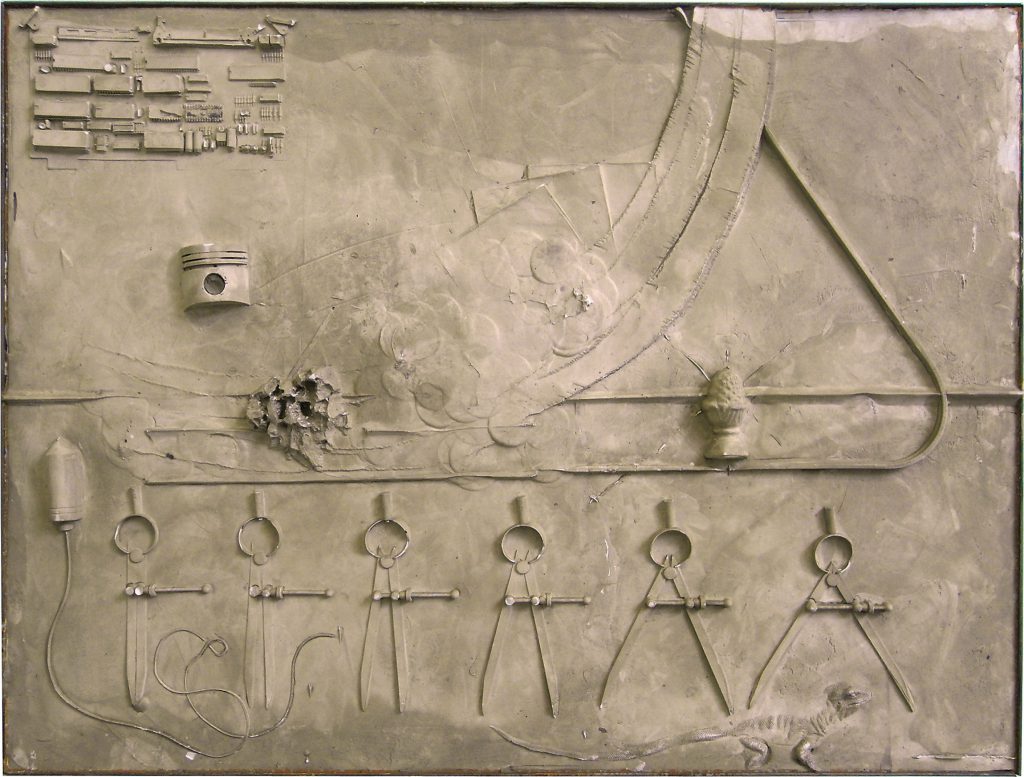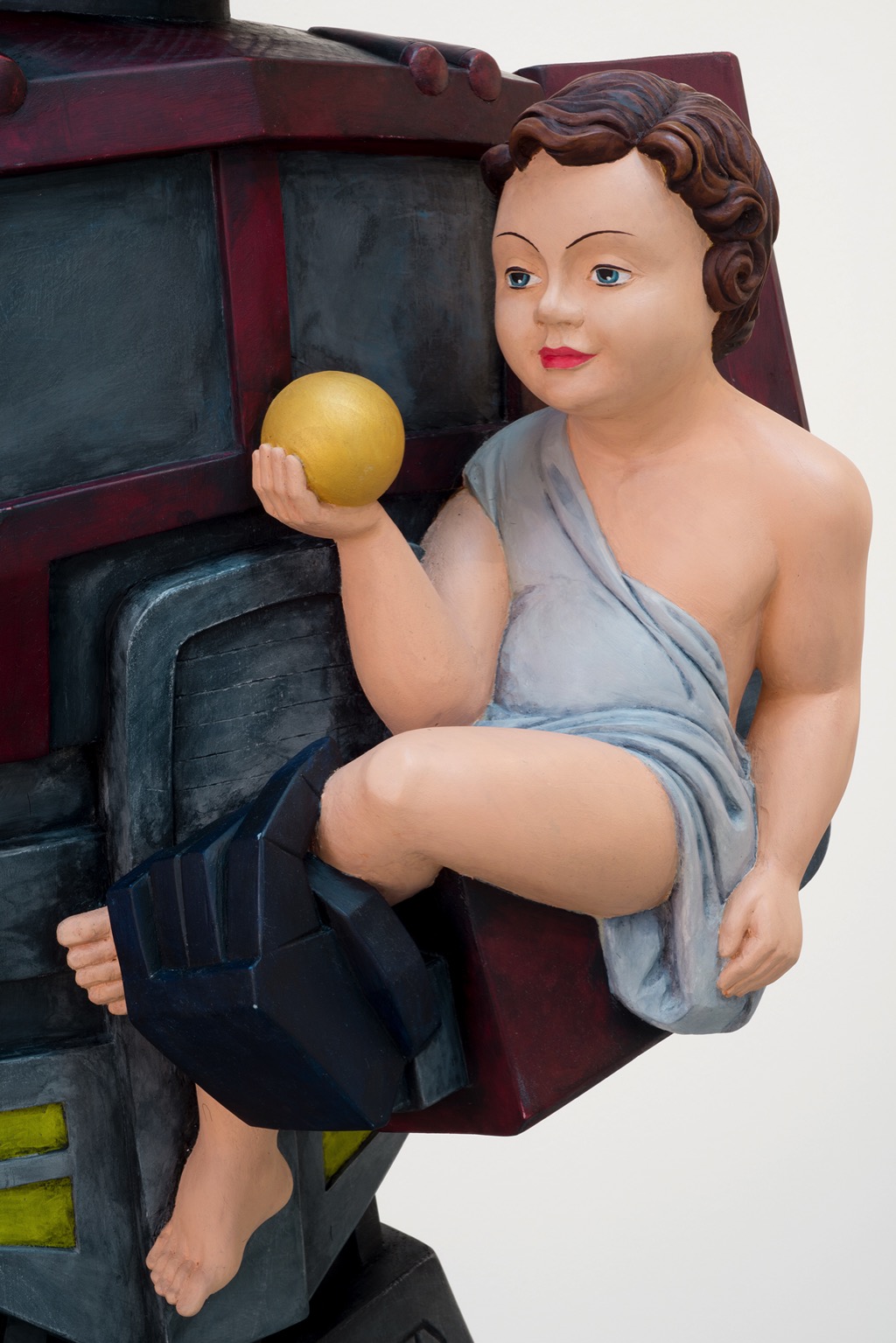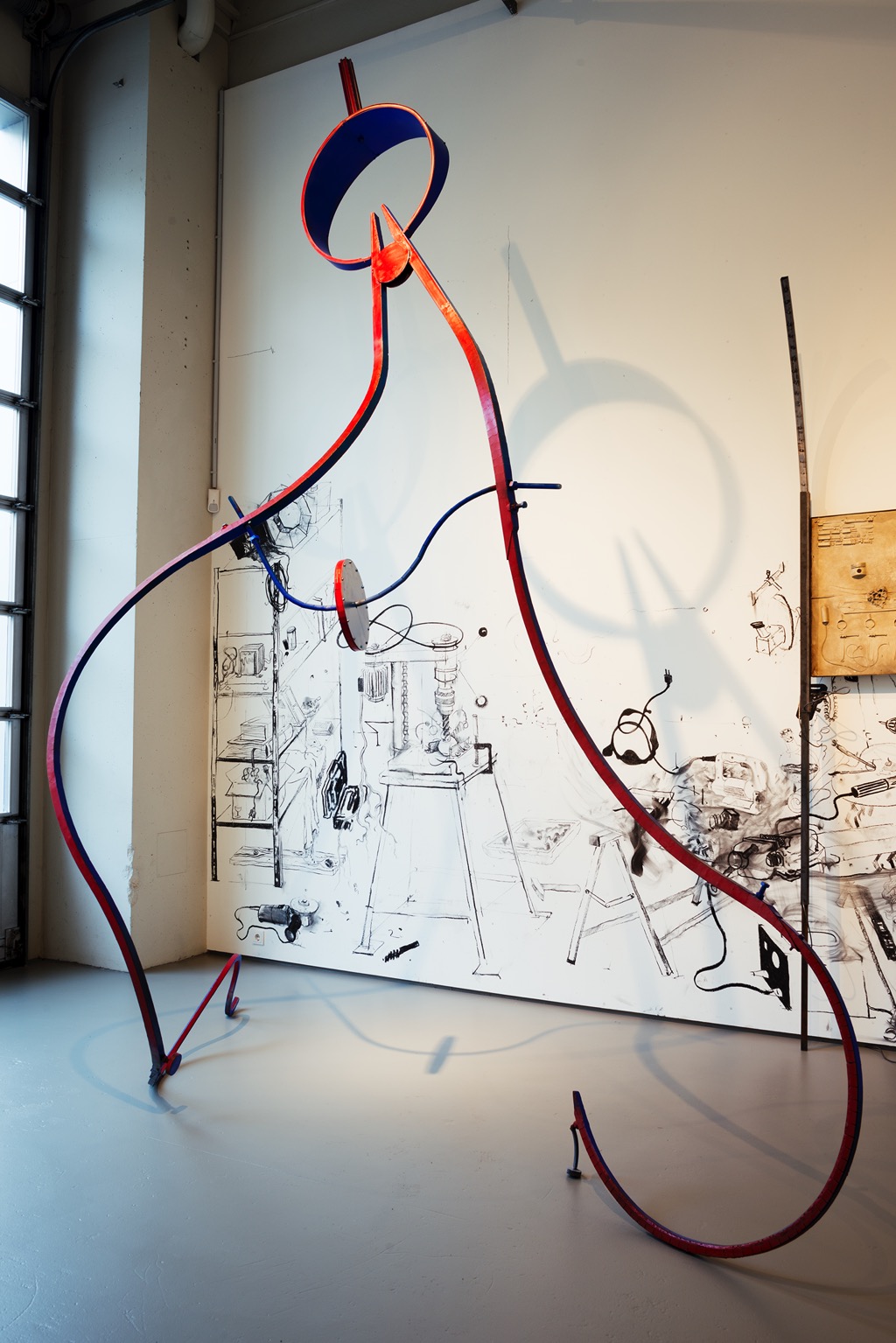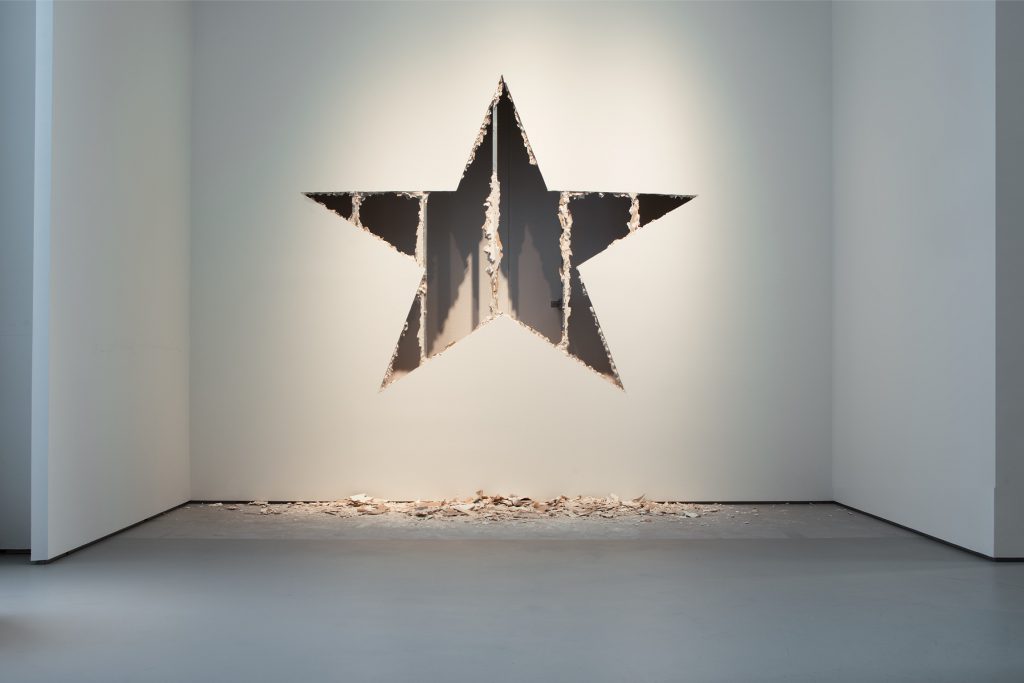Cluj Connection 3D
Mihuț Boșcu Kafchin, Răzvan Botiș, Mircea Cantor, Radu Cioca, Ciprian Mureşan, Vlad Olariu, Cristi Pogăcean, Gabriela Vanga
Curated by Jane Neal
Works

Vlad Olariu
Constantinople
2013
EPS foam, resin and cement
250 × 200 × 10 cm

Radu Cioca
Inner Song [1]
2010–14
Ceramics, inox, aluminium, wood, metal, neon light and glass
127 × 110 × 110 cm

Radu Cioca
Becoming Object 3
2013
Concrete, wood and metal
69 × 46 × 10 cm
Private collection, Timisoara, Romania

Răzvan Botiș
Hit the Road Jack
2010
Glass, whisky and rubber
110 × 15 × 5 cm

Mircea Cantor
Future Gifts
2014
Black Marquiña marble, concrete, white Carrara marble
each 49 × 40 × 40 cm
Courtesy of Magazzino, Rome

Mihuț Boșcu Kafchin
Steps to Geometric Divination
2015
Plaster, artist’s frame
73.5 × 98 × 5 cm


Cristi Pogăcean
Optimus Prime (Detail)
2014
Carved wood and paint
200 × 80 × 70 cm

Cristi Pogăcean
Optimus Prime
2014
Carved wood and paint
200 × 80 × 70 cm

Ciprian Mureşan
1
2013/2015
Bronze
21.5 × 21 × 12 cm

Ciprian Mureşan
The End of the Five-Year Plan
2004
Mixed media
Dimensions variable

Vlad Olariu
Formula for General and Elementary Statistics
2015
EPS foam, resin and cement
ca. 320 pieces, dimensions variable

Gabriela Vanga
Candle Clock
2015
Candles and steel
171 × 171 × ca. 20 cm

Răzvan Botiș
Hidden Knife
2009/2015
Potted plant and knife
Dimensions variable

Răzvan Botiș
Lady Justice
2015
Sheet metal, wire and spraypaint
330 × 230 cm

Gabriela Vanga
LXXXXI
2015
Leather shoes from size 22 to 42 and titanium powder
Dimensions variable

Cristi Pogăcean
Plaster model for “Bird of Prey”
2015
Plaster and stainless steel
95 × 28 × 10 cm

Mihuț Boșcu Kafchin
Wind Compass
2015
Steel
Dimensions variable

Mircea Cantor
Hypothetical Geriatric Selfie
2015
Installation
3.14 × 3.14 m
1 ¼ × 1 ¼ m

Radu Cioca
Being built [1]
2014–15
Black concrete and metal
75 × 87.5 × 5.5 cm (bas relief), 175 × 115 × 70 cm (overall)

Gabriela Vanga
No Secondary Thought
2011
Lego bricks
167 × 65 × 6 cm
Text
Galerie Judin is pleased to present Cluj Connection 3D, an exhibition that brings together eight artists connected to Cluj, Romania, who are working with sculpture and installation: Mihuț Boșcu Kafchin, Răzvan Botiș, Mircea Cantor, Radu Cioca, Ciprian Mureşan, Vlad Olariu, Cristi Pogăcean and Gabriela Vanga. Several of the participants are already well-known, successful figures in the international art world, others are younger, promising artists, just beginning to attract attention.
The exhibition is a sequel to the seminal exhibition: Cluj Connection, curated by Jane Neal in 2006, in collaboration with the Romanian artist/curator and director of Plan B Gallery, Mihai Pop, for Juerg Judin, the then director of Haunch of Venison Gallery, Zurich. Cluj Connection 3D reunites the team behind the original exhibition, at the eponymous Galerie Judin in Berlin and four of the original artists: Mircea Cantor, Ciprian Mureşan, Cristi Pogăcean and Gabriela Vanga.
In the ensuing nine years since the first exhibition, it has been interesting to note that though many of Cluj’s artists are now recognized internationally, and several of them have come to be described as ‘stars’, it is painting and painters such as Adrian Ghenie and Victor Man that Cluj has come to be most renowned for. However, if the art world has previously focused more on Cluj’s painters than its sculptors (with the exception of Cantor and Mureşan who are internationally recognized and respected figures), the time has now come for it to readjust and widen its lens.
Continue reading
Nearly a decade on from the original Cluj Connection exhibition, Cluj Connection 3D has been organized in order to re-formulate the ideas of the original show and draw attention to the fact that – along with Cantor, Mureşan and Vanga, several of the most promising artists of the younger generation in Cluj are in fact working in three, as well as two dimensions. Some of these could be described as sculptors, or as multi-media artists with a focus on sculpture and installation, and in a similar vein to Cluj’s painters, they succeed in marrying a greater awareness of the behavioral properties of their chosen medium and technical proficiency in its handling, with a solid grounding in the theories and movements that have dominated the development of sculpture throughout the 20th and into the 21st Century.
With much of contemporary sculpture focusing on the medium’s physical characteristics, the object’s relationship with the viewer is often overlooked. The participatory aspect of sculpture and the need for a viewer to accept a degree of responsibility during the process of engaging with an encountered object are something that all of the artists in Cluj Connection 3D are aware of and share. Also apparent is that the majority of the work in the exhibition revolves around the existential questions thrown up by our human condition. The art historian Georges Didi-Hubermann describes how, as we come face to face with sculpture (which he believes we often unconsciously perceive as a hollow, empty vessel), we experience a deep-seated fear of emptiness and death. Not surprisingly the memento mori is a theme that can be found occurring throughout the show: sometimes explicitly, in the form of the archetypal skull (in this case piled into a giant mound by Olariu, who was inspired by the 19th Century painting The Apotheosis of War (1871) by Vasily Vasilyevich Vereshchagin), or expressed as a hidden, but thinly veiled threat, such as a hidden knife within an aloe vera plant, which Botiș explores.
The politics of power and the role of Church and State (still very much in focus in Romania and often the subject of controversy) are also questioned in the context of this exhibition, notably by Mureşan in Teoctist, his re working of Maurizio Catelan‘s iconoclastic sculpture, with the Romanian Patriarch being hit by a thunder bolt. The struggle for supremacy, the employment of propaganda and the age-old tension between East and West, are brought up to date and catapulted into the 21st Century while simultaneously being exposed as ancient, ever-repeating patterns: Cioca uses bas-relief to consider the ongoing role of propaganda in Being Built, and Olariu has recreated the Siege of Constantinople with a twist: it is carved not out of stone, but from the decidedly modern, industrial packaging product, styrofoam. Warfare and weaponry are sometimes directly referenced, at other times, alluded to, and throughout Cluj Connection 3D, there are constant reminders of man’s battles and fears.
A number of the younger artists, like Boșcu Kafchin, Cioca and Olariu, are engaged in revisiting the ancient sculptural traditions of the frieze and the bas-relief. The tradition of the monument has also been reconfigured: the figure of the hero and a winged Nike have been re-formulated and re-contextualized. Pogăcean has combined the classical hero and the religious icon in a giant recreation of the Transformers cartoon figure Optimus Prime, and Vanga has moved from Nike into a Lego bow and arrow in No Secondary Thought – a not so oblique reference to how children become familiar with weapons of warfare, or even with fighting directly. These powerful symbols are balanced in the exhibition by fluid expressions of form, such as in the ambitious large-scale sheet-metal installations of Boșcu Kafchin and the re-worked Calder mobile of Botiș; both artists being highly influenced by the drawings of some of the great figures of the last century, like Marcel Duchamp or Cy Twombly.
Humor and irony also lace through the works of the exhibition, counterbalancing the more serious themes. One darkly humorous example takes the form of a model of the Greek Orthodox cathedral that has proven controversial in Romania for its enormous size, huge cost and potential location. It is to be erected directly opposite the parliament housed in Ceausescu‘s infamous ’People‘s Palace’. The artist, Mureşan, has made the model on a scale of 1:666, leaving us in no doubt that he, at least, regards the proposal for the cathedral as diabolical.
Myths and folk traditions sit comfortably alongside the formal concerns of the exhibited works – one of the most poignant being Cantor‘s reference to Brancusi’s final birds from his ‘Bird in Space’ series that he sent off to an Indian prince, who wanted them for a planned temple of meditation – Brancusi had always wanted to combine his works of sculpture with architecture, so he designed the temple too, which would have housed three of the birds. Two of these three birds were realized and sent off to India, but the project and the third bird were never completed. Cantor gives the story a happier ending by honoring Brancusi’s original intention and producing three Future Gifts.
Cioca‘s Inner Voice, which reveals two porcelain doves, one seemingly bursting forth from the other, also plays to the poetic, as does Vanga with her subtle but poignantly personal reference to the family unit and its interaction with the world around it, through a flower made from her family’s shoes. A stencil traced in pigment symbolizes the paths that crisscross between those within the family and those entering from outside, reinforcing the notion of the constant state of flux in the private ‘safe’ realm of home and the unpredictable nature of what might lie outside in the wider world. References to contemporary popular culture are also present in the exhibition. For example, Cantor’s most recent work, Hypothetical Geriatric Selfie (2014), engages with the notion of the selfie in the form of a giant star, hand-carved and drilled into the wall of the otherwise pristine gallery. The title suggests two interpretations. On the one hand, it is evocative of an ancient and persistent symbol carved by the artist so as to tell whoever discovers it, ‘I was here’. On the other, it reminds us that we sometimes see the light from a star which, because of the speed at which light travels, no longer exists – leaving us looking at an old and empty space.
In Cluj Connection 3D, sculpture, as a deliberate act of deconstruction in the structuralist sense, balances with surrealist-inspired, dreamlike visions of twisted metal that evoke drawing in space rather than solid or concrete forms. Interestingly, the interplay of coolly contrived objects with playful constructions, hard-hitting installations with humorous or ironic interventions, and a general mingling of influences and varying artistic concerns, is very much in keeping with the vibrancy of the cultural background of Cluj itself. Historically, the city has always been multicultural, challenging and labile. Situated approximately halfway between Bucharest and Budapest, and with a diverse population of Hungarians, Saxons and Jews – as well as the now predominant Romanians, Cluj has long been a crossroads for peoples and empires, and, like the rest of Transylvania, a cultural heartland.
Jane Neal is a leading expert on the contemporary art scene in Eastern Europe, writes for a variety of international publications and recently co-authored Cities of the Future: 21 Century Avant Gardes (Phaidon). She has curated critically acclaimed exhibitions in Austin, Berlin, Budapest, Dubai, London, Los Angeles, Milan, Mumbai, New York, Prague, and Zurich. Recent exhibitions include a European figurative painting show for S/2 in London entitled „This Side of Paradise“ (2014) and „Nightfall: New Tendencies in Figurative Painting“ at MODEM Centre for Contemporary Arts, Debrecen, Hungary (2012), which traveled to the Rudolfinum in Prague in 2013. Neal was educated at Oxford University and the Courtauld Institute, London, and lives and works in Oxford and London.




















